A conversation with artist, Annabelle Lynne, on her work, the implications of parasocial relationships, and celebrity as the modern mythology.
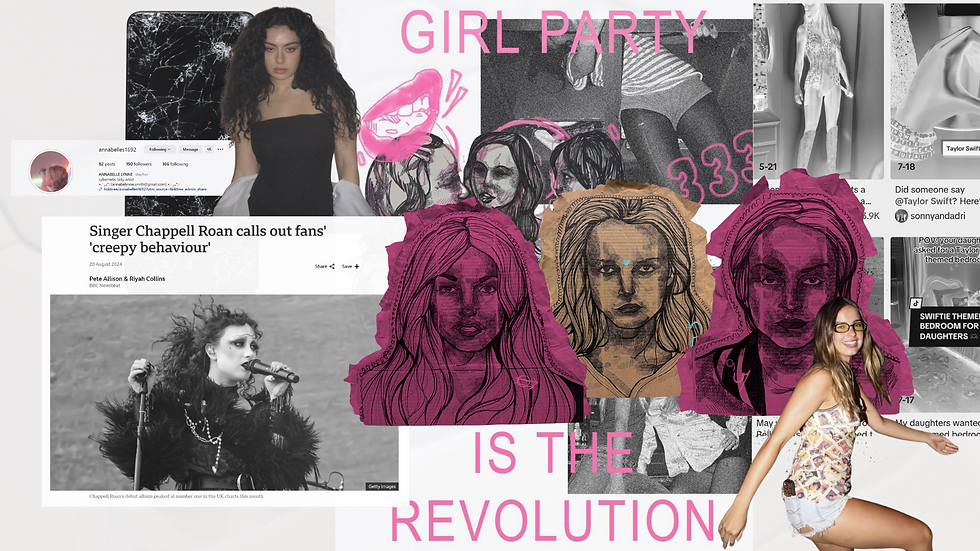
Charli xcx and Addison Rae are two names that strike a chord with many on the internet today, both as pop stars and personalities. Charli, today's it girl and yesterday’s legend in the underground hyper-pop scene, has formed a very public friendship with Addison, a TikTok star turned pop aspirant. Through collaborations and outspoken exclamations, Charli has given her blessing to Addison. On stage in Los Angeles, Addison joined Charli to perform the ‘Von Dutch’ remix. The image of these two young women writhing in the spotlight together, living in the moment and owning the stage is one familiar to many who research or revel in pop performance. Moments and images such as these create a sense of freedom and confidence that many aspire to, something beautiful, seemingly otherworldly, and maybe better?
A few weeks later, I came upon this same image, except this time it was different. Created and posted by the artist Annabelle Lynne (@annabelles1692), I saw Charli on her hands and knees singing to Addison who was throwing her head back. The two were cardboard cutouts, in front of an abandoned storefront. Breaking down the fourth wall, seeing these larger than life figures in such a space brought to mind so many questions and thoughts. However, before I could begin to chase these thoughts, Annabelle Lynne’s caption stopped me in my tracks.
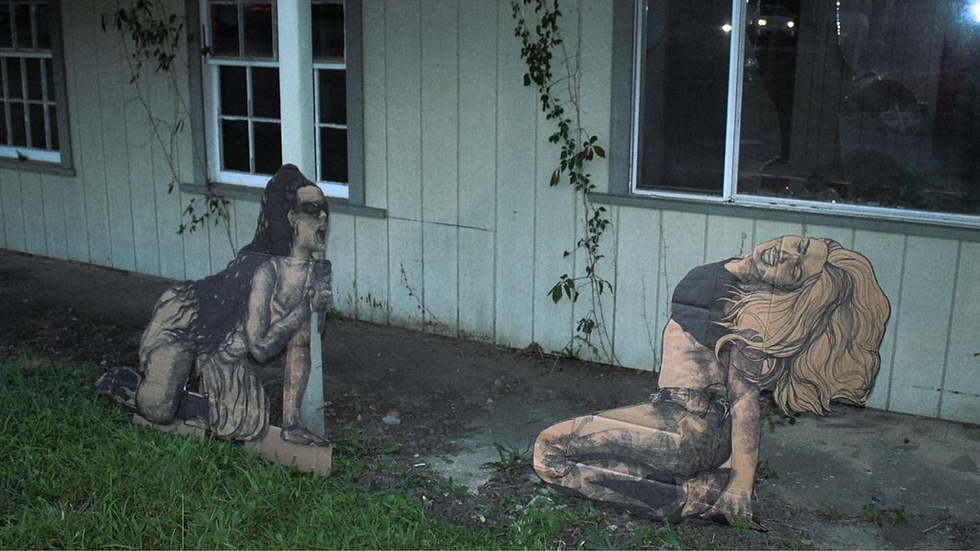
“I see this as both a love letter and a caution against love letters - how real are these people? How real can we make them, without ever really knowing them? I'm not sure. I'm scared to find out.”
As a follower of Lynne’s work, and an avid student of celebrity and pop culture, I am fascinated by how she intertwines celebrity narratives with mythology and nostalgia. After this most recent piece, I knew I had to talk with her. I wondered, how can we use the concept of celebrity to better understand ourselves and our humanity?
After connecting on Instagram and aligning our schedules, I called up Annabelle on a Thursday afternoon. With my notebook open, I couldn't wait to dive into our conversation. I had so many questions and I was eager to ask them.
She and I greeted one another with earnest enthusiasm, and before long we were off…
I began by questioning how she became interested in portraying celebrities, of the early 2000’s and today. Simply asking, “What inspired you to create these illustrations of figures like Charli, and even Britney and Lindsay?”
Annabelle replied, “I feel like using pop culture or the cult of celebrity as an artistic theme is something that's become less taboo recently.” She continued on to express how women have often been relegated to “lesser subjects” in the art world. “It was just sort of letting myself admit that this is where my interest is and what I'm really interested in - so it's kind of a tribute, this like kind of offering, but it's also commentary.”
She expressed how she has a complex relationship with the idea of celebrity, especially with these “archetypal women” like “Britney Spears and Lindsay Lohan” and how drawing them has become a repetitive meditation.
In Annabelle’s Instagram bio she describes herself as a ‘cybernetic lady artist.’ Curious, I asked how she would define cybernetic, and how she would say that term applies to her work?
She explained, “I feel like putting my sort of net art part, portion of my practice, first, because even in my more physical pieces, the internet, it is so important to it. I just feel like it's a good descriptor for how I'm trying to weave both of those things together. You know, both using code online as a sort of almost like craft medium, right? Weaving things together, but then also bringing the Internet into reality and making pieces based off of things that happened online into the physical realm.” She went on to in greater detail, “I feel like it helps me feel closer to code and software. Everything I do is affected by being a woman and loving women and so, you know, weaving, traditional craft art, fiber arts, those sorts of things. I haven't practiced those mediums specifically, but coding helps me kind of feel more connected to that in a way that it's another dimension.”
As our conversation veered into subjects of the internet and digital spaces, I couldn’t help but wonder, how our current online environments affect our sense of reality and connection? Thinking back to that caption, “How real can we make them, without ever really knowing them? I'm not sure. I'm scared to find out.” So, I asked Annabelle for her thoughts.
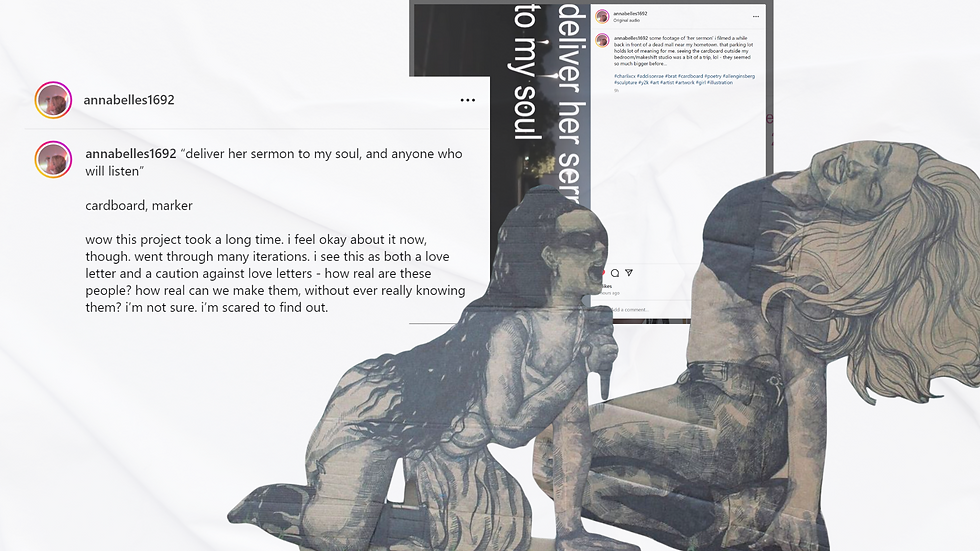
She replied, “Yeah, I feel like there's so little, actually, there's no boundary left in connecting to these celebrities because of the internet.” She continued on to say how she feels that today’s online spaces can be very positive, however they have their limits and can foster unhealthy behaviors saying, “I do think the internet is overall, such a positive tool for community and finding space. I think a tool can be used by the wrong people and a lot of the more popular social media accounts or social trends that we have now - it feels like they're manufactured to do the exact opposite of finding a solid community and instead further isolate and antagonize people.”
We discussed how Chappell Roan’s recent statement rightfully called out unethical behavior she had experienced from individuals who perceived themselves as fans. The backlash she received for such a simple statement only reiterated how our society expects certain performances from celebrities to continue offstage. Especially when these celebrities are young women. There is a demand for performances of constant gratitude even when they experience abuse or mistreatment.
This is where we lose our grip on reality, seeing these individuals as higher beings, with greater responsibilities, and personal connections to us. Annabelle has made a comparison to mythology and fantasy clear in her pieces, like the The Myth of Sisyphus. So, I asked her, “What do you want your viewers to take away from this comparison to celebrity narratives as mythos?”

“I find that connection of celebrity and mythology really fascinating. I feel like it is so interlinked now because we don't have that sort of general population deity to look up to, and so instead, we've kind of idolized these people.” Addressing the Chappell Roan statement, she said, “some people that have spoken to about it have specifically used the word idol. Like, ‘well, she signed up to be an idol. This is what she wanted to be.’ I don't actually think that's what she was doing who's signing up to be a deity.”
She explained how her Charli and Addison piece was influenced by this concept, how “spending hours precisely making these strokes with markers on cardboard.” Made the work feel very “ritualistic and religious.”
“I know that they're not deities. It's almost commentary on the fact that, like, if it were socially acceptable, I feel like people would construct temples to, you know, Taylor Swift or something like that. And - we kind of do, on the internet anyway…”
I thought back on my own experiences with fandom and celebrity culture. I wondered and asked, “is the cardboard cutout the ultimate fantasy?”
She stated, “It is sort of the ultimate fantasy. You're bringing these people into your life, into your bedroom, and then you can, you know, talk to them.”
She explained how the cardboard studies and pieces were born out of necessity rather than connection to the kitsch cutouts. Since she is a student, working with inexpensive and abundant materials is a huge benefit. “I started making them, and then I kind of made the connection.”
“Cardboard is so interesting to me too, because it's very durable. You could do a lot to it, but at the same time, you know, the wind blows and the cardboard cutout falls to the ground, and then suddenly it loses all of its dimensionality. It's just one surface. And I thought that was really interesting, too.” She explained further, “the piece is performing itself. You know that it'll just decide to topple when it does, and then suddenly it's no longer a person. You know, they're, they're no longer in my room. I'm reminded of the fact that it is just a fantasy.”
Fantasy, is it really all bad? Connections to artists and their work can be beautiful but where do we draw the line? As a student of pop-culture and pop-icons, I can’t help but think of the ways in which I have connected with individuals through their performances, personas, and art. For so many, we find comfort in our icons and idols. We see ourselves reflected in them. We want to root for them.
So, I posed this same question to Annabelle. She responded, “I don't think it's all bad.”
“I think you're totally right in saying that there is so much we can learn, and that's not just learn from their art, but also learn, emotionally from these people. - I think it just gets dangerous when you forget that it's not a two way connection, right?”
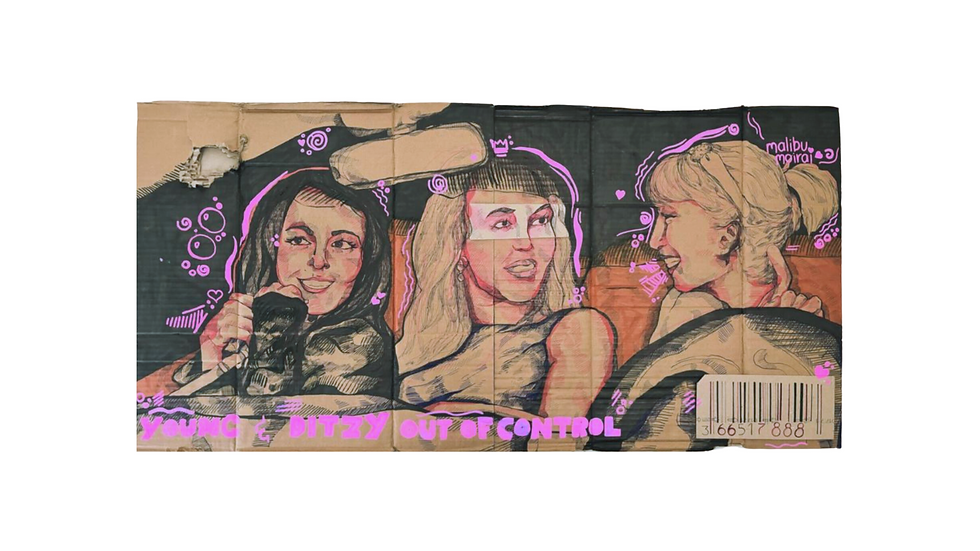
I couldn’t help but bring up the Free Britney movement. A moment that presented this complex relationship of fan and idol on a scale almost never seen before. Fans were actually speaking on the behalf of Spears, as she was silenced by unjust legal measures. Although this seemed to be a beautiful example of advocacy, since Britney has regained freedom from her conservatorship, she has seen no end of criticism.
I asked, “What can we learn from Britney?”
“I feel like what we can learn from Britney is so much because she's such an incredible artist and also just such an intelligent woman in general. Whoever was the ‘savior’, also had ulterior motives, you know, including the fans.” She went on to address the demands for performance, “Why did you do that? You know it wasn't just out of the good of your heart or your love for her. Your love is conditional.”
We continued to question and dig into our patriarchal society's projection of the feminine ideal that makes this pressure two-fold, you must be a perfect idol, you must be the perfect woman, or we don't want you. Stay young, stay healthy, stay grateful, stay beautiful, how could you not? We are holding these adult women who have evolved and gone through unimaginable experiences to the standards of like their adolescent selves. Another idol of the early 2000’s, Amanda Bynes, is experiencing similar backlash online.
Annabelle expressed, “because she has completely changed, which is understandable regardless of whatever she went through, she was a teenager, and now she is a grown woman.” While Bynes is currently pursuing a career as a nail tech and occasionally sharing moments of her life on TikTok, she unfortunately faces constant questioning, prodding, and wishes for her “old self” to return. Annabelle explained, “her fans will say we're doing this out of caring and loving for her, and then expect similar things to what her abusers and controllers expected from her. - All right, well, who's the good guy and who's the bad guy?”
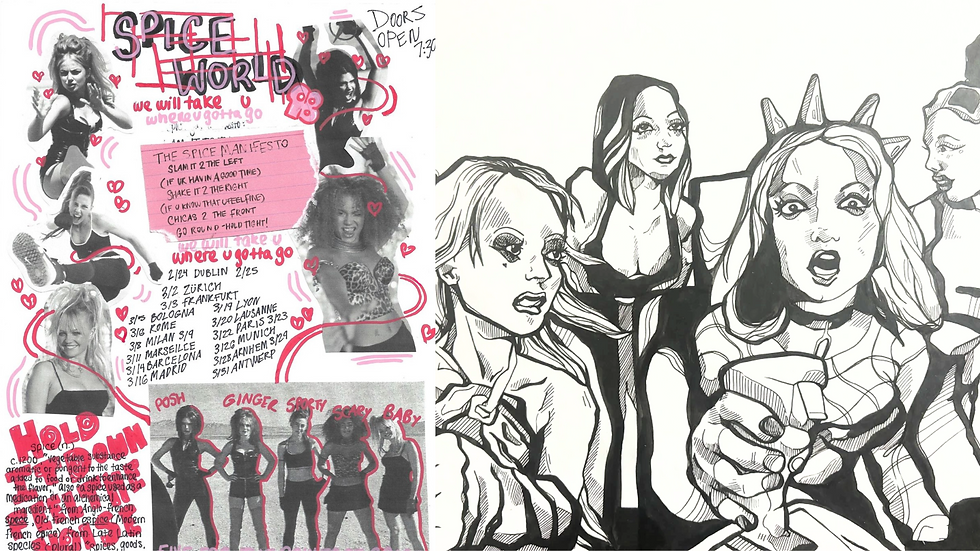
It is clear to me that Annabelle’s work is critiquing these ideas. Pushing back at the abuse faced by early 2000’s celebrities through intentional study. Taking their stories seriously and looking at the implications they have on the lives of everyday women.
She told me, “I'm trying to push against that, and I guess that's another thing that I'm learning from Britney, is pushing against that, and how to not feel bad for not meeting other people's expectations.”
Finally, I asked Annabelle what she saw as the driving force behind her work. Was it girlhood, nostalgia, maybe confrontation?
She replied, “I feel like my answer is kind of nebulous. It's just kind of that reaching for girlhood. In both the sense of dissecting girls and then also finding community, girls that I know and girls that I don't.”
As our conversation came to a close, I was honored to be a part of Annabelle’s community. Her pieces spoke to me and I am sure they will continue to resonate with many. Her reverence for femme stories and traditions is so clear. Through detailed studies, illustrations, and thoughtful performances, she has found a way to break down such dense topics in truly beautiful ways. There was no else I would have rather discussed parasocial celebrity dilemmas with.
It was an honor to connect with Annabelle. She continues to share her artwork on Instagram and uses her blog platform Today Girl to connect with others and continue her project of community building. You can find Annabelle's work @annabelles1692 on instagram and youtube to see more of her amazing pieces and follow her journey.
Thank you Annabelle for sharing your amazing work and insights with the blog <3
BY REBECCA DOYLE

Comments